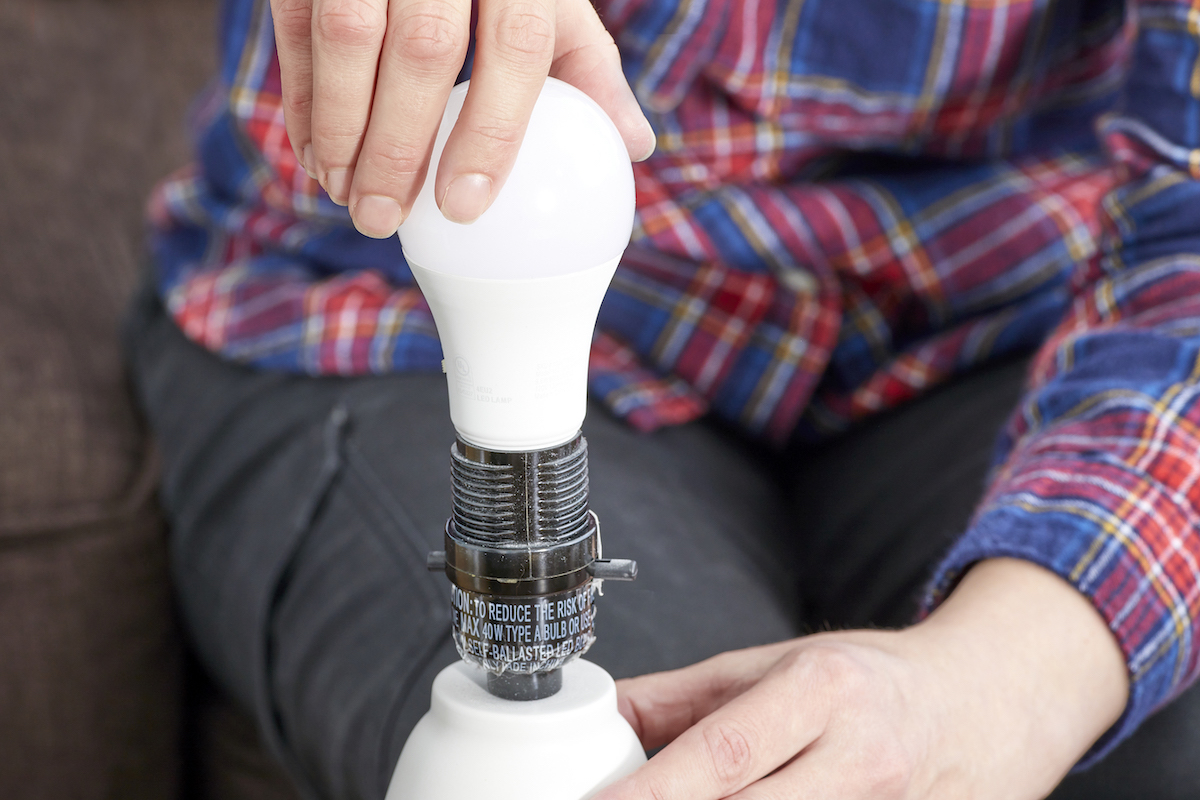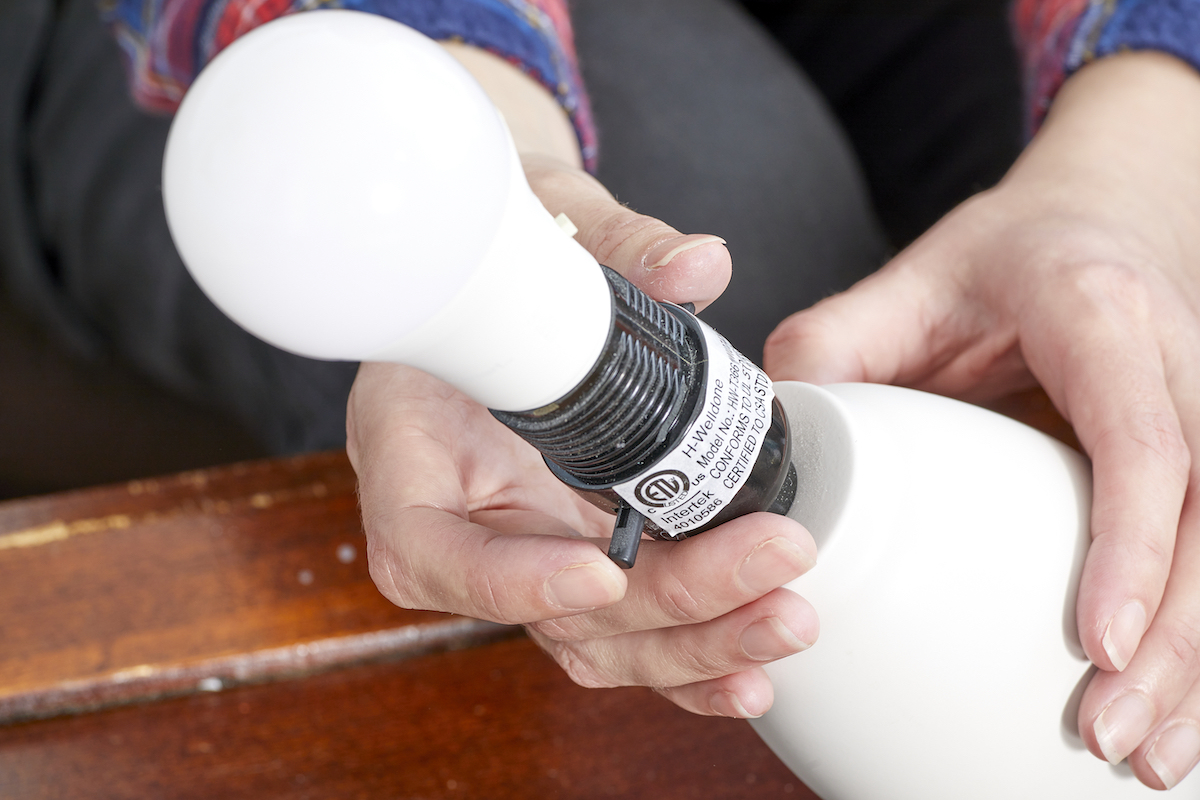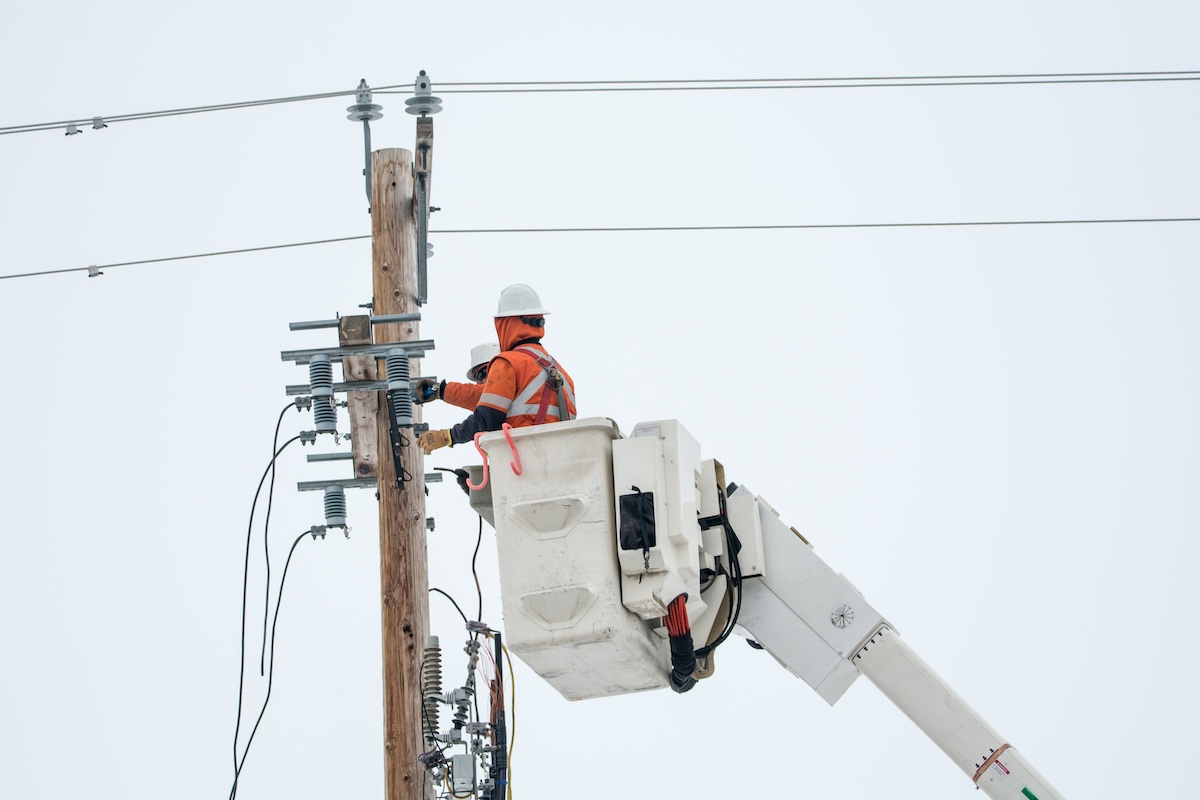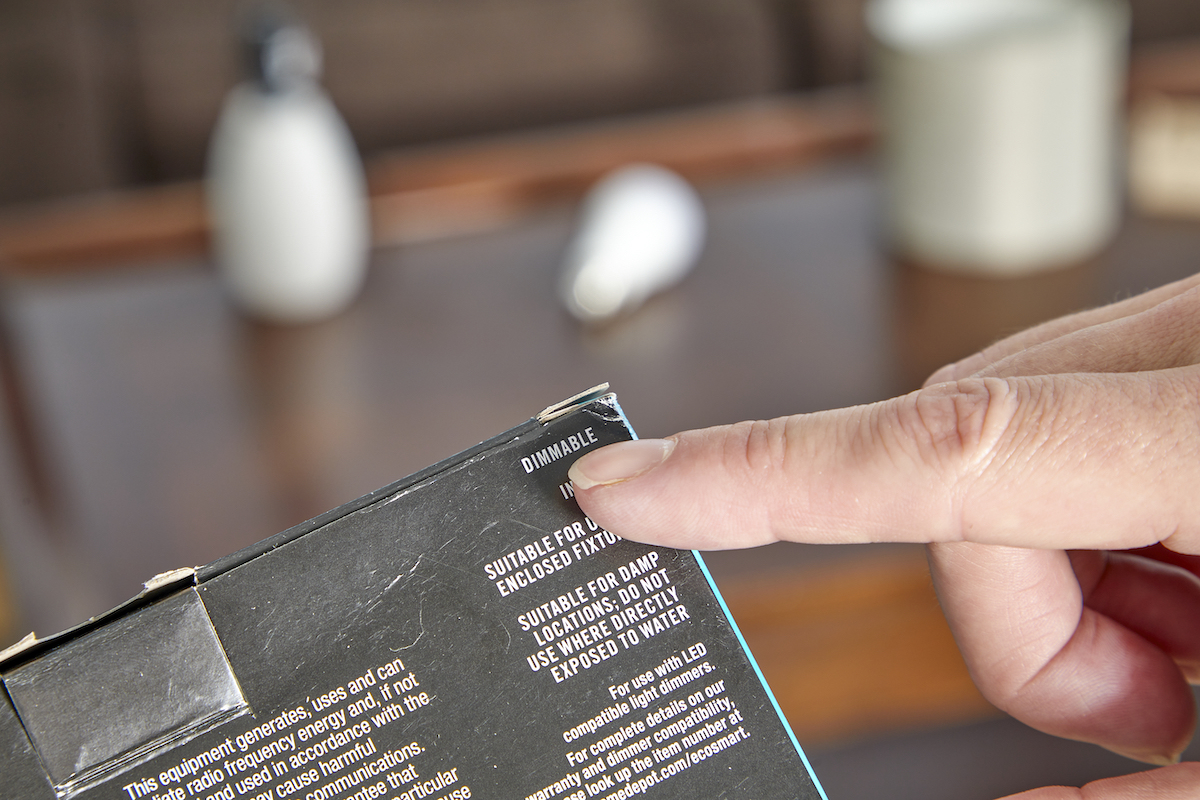

We may earn revenue from the products available on this page and participate in affiliate programs. Learn More ›
Flickering lights can be disconcerting when you don’t know the cause, or how to fix it. According to certified master electrician Kyle Krueger, “There could be any number of reasons, both major issues and minor issues,” to explain flickering lights. Short of festive holiday lights or decorative faux candles, light bulb flickering in a standard fixture is not normal.
Krueger, who is also the executive director of codes and standards for the National Electrical Contractors Association (NECA)*, says that the most common causes of flickering lights “are specific to other loads in the house.” Electricians watch for signs that help pinpoint why lights are flickering so they can fix the underlying problem. Although flickering lights might not represent immediate danger, they might be a warning sign of a serious issue that usually requires calling in a pro. Ahead, discover the most common causes for why your lights might be flickering, and what to do about them.
Are flickering lights dangerous?
If you are wondering if it’s dangerous when you see lights flickering in houses, the answer depends on the source of the problem. A bulb that’s loose in the lamp socket does not present a fire hazard, but other causes warrant concern. “I would say that the most dangerous situation that could cause flickering lights would be loose electrical connections, poor connections, or faulty wiring,” says Krueger. Although the problem can occur in any house, it is most common in older homes.
Loose connections that cause flickering lights and a popping sound indicate arcing—a type of electrical discharge—in the junction box. “This would be a definite warning sign that something is not right and it should be checked out by an electrician right away,” he says. Continual arcing creates high temperatures in the junction box. Krueger says since most houses are made of wood and contain insulation in the walls, both of which are flammable, the problem can cause a fire.
The National Fire Protection Association reports that from 2015 to 2019, electrical distribution or lighting equipment was involved in more than 36,000 home structure fires each year. Since these causes ranked first for property damage and third among major fire causes, as well as causes of fires leading to injuries and death, flickering light bulbs should not be taken lightly and that solving electrical issues is critical for fire safety.
Simple Causes of Flickering Lights
Some solutions to lights flickering in the house are simple enough to spot and fix right away. Start with these before assuming a deeper problem is behind flickering lights.
The bulb may be loose.

How many homeowners does it take to screw in a light bulb? The answer is one, but that one person needs to screw it in correctly to keep it from flickering. Try these steps to identify and fix the flicker:
- Note whether the flickering is isolated to a single lamp or other light fixture, and if the bulb was replaced recently.
- Turn off the light fixture.
- Twist the bulb so it sits tightly enough in the socket to make a connection.
- Turn the light back on to see if the flickering has stopped.
You may have a faulty fixture switch or a loose light plug.

Electricity is all about the connections: A loose one between the on-off switch on your lamp or light fixture and the light bulb could be the culprit, so try these steps:
- Wiggle the switch gently to see if it evokes a flicker; if yes, follow these steps to replace the switch.
- If it doesn’t appear to be a loose switch, see if the plug is loose from the wall outlet.
- If so, unplug the lamp, adjust the plug’s metal prongs, and plug it back in to see if that was the cause.
You aren’t using the right bulb for the fixture.
Another simple reason why one or more lights dim or flicker has to do with the bulb type. For example, bulbs flickering outside might have to do with the temperature, and bulbs installed on switches with dimmers can flicker if the switch and bulb are incompatible (see more on bulb types and flickering below).
- Note whether the flickering is confined to a single fixture or a single bulb within a fixture, switch the fixture off, and check to see if the bulb and plug are secured tightly.
- If all the bulbs in a fixture are the same and they are attached to a dimmer switch, try a different bulb type or check the switch’s compatibility per the advice below.
You may have large appliances on the same circuit as the light fixture.
Krueger says that one of the most common causes of flickering lights has to do with having large appliances on the same circuit as the dimming or flickering light fixture. This problem is especially common in older homes. Refrigerators, dishwashers, and AC units draw a lot of current when they turn on, which “essentially creates a voltage drop situation and the lights will dim momentarily,” says Krueger. To determine whether your flickering lights have to do with your appliances, try this:
- Pay attention to the patterns. Note whether the lights flicker when large appliances start.
- If you are still unsure, use a multimeter to gauge the voltage or hire an electrician to take a look.
- The only true fix, says Krueger, is for an electrician to “install additional separate circuits for some of the appliance loads.”
“The appliance startup is not necessarily dangerous,” says Krueger. Continually overloading the circuit can be a serious issue, he says, “but that’s why we have fuses and circuit breakers, to shut the circuit down.” Newer homes are required to have dedicated circuits for these large appliances to prevent loading issues.
More Serious Reasons Your Lights Are Flickering

Not all flickering lights are easy fixes. Some may require more in-depth work, or hiring an electrician to make repairs.
Loose, faulty, or damaged wires or connections could be the cause.
Lights flickering in one room could indicate a problem with the wiring. Connections and wiring can age over time. Faulty wiring could be from deteriorating wire, animals chewing through wiring, or even poorly installed wire nuts or connectors. Krueger says that sometimes hanging pictures in a new home can lead to screws or nails going through the wall and hitting a wire. It might not create an immediate issue, but over time, it can lead to flickering lights on the connection.
If lights flicker randomly, it is often caused by a loose wire. When they dim or flicker, note whether a large appliance has kicked on.
- If the flickering seems unrelated to appliance startup, turn off any noises, like a television or air cleaner, and turn the light on again to check for a popping or crackling sound. “That popping noise is not very loud, but loud enough in a quiet room if there is a loose connection,” says Krueger. The popping sound is arcing, which can lead to high temperatures and fires.
- When the random flickering continues for no other known cause, and especially if you hear popping, contact an electrician right away. Meanwhile, you can cut off power to the damaged wire by shutting off the corresponding circuit breaker in your breaker box.
In newer homes, arc fault circuit interrupters are protective devices installed at the electrical panel. “It monitors the various circuit wiring for arcing,” says Krueger. These devices will shut down a circuit when they detect an arcing signature.
The connections bringing power to your home might be faulty.
Although less common than other causes of flickering lights, a voltage issue might be the root of the problem. Power comes in overhead or underground, and every so often, the connections to the electrical service outside can become bad or faulty, says Krueger.
- Look for flickering lights throughout the house, since the connections affect multiple circuits, not a single one.
- If you note the problems in multiple rooms, or with multiple appliances not working, it could be the main connection.
- Contact your electric service or a licensed electrician.
You may be experiencing a neighborhood or utility company issue.
Your home shares a transformer with surrounding homes, so your flickering lights may be caused by your neighbors’ heavy electrical usage or by nearby office buildings. Sometimes, downed trees or other damage affects the power lines. Flickering lights also can be related to a brief power outage.
- Think about neighbors with high usage and if flickering most often occurs in relation to when neighbors are home or office buildings are full.
- Brief power outages can occur from trees or animals coming into contact with power lines, or from two lines brushing up against one another and causing a fault in utility lines.
- If you are experiencing severe weather or a recent outage, breakers at the utility company might be kicking on and off to prevent a long-term outage. The flickering would last for just a second or two, and it might come just before a power loss.
- Check to see if power appears to be out in neighbors’ homes.
- Contact the power company to report an outage, and contact a licensed electrician if you are unsure about the cause.
Types of Light Bulbs and Why They Flicker

Flickering might be caused by having the wrong type of light bulb in a particular fixture, especially as technology for lighting advances.
- LED bulbs work through an electronic driver. Placing them in a fixture with a traditional dimmer switch is the most common cause of intermittent flickering LED lights, and it is not dangerous. Krueger says to dim LED light bulbs, you must have an LED dimmer switch. Otherwise, the bulbs flicker because the old dimmer “is robbing that driver of the necessary voltage, so it won’t work like it’s supposed to,” he says.
- Fluorescent bulbs tend to flicker frequently, and this can be caused by everyday factors like cold temperatures, the bulb burning out in the socket, and the way that phosphors power up to their maximum level. A fluorescent light flickering every now and again is probably not a huge concern; replace old bulbs as necessary.
- Compact fluorescent (CFL) bulbs might flicker from temperature variations, or as they warm up when first turned on. If neither of those is the cause, a flickering CFL bulb may be ready for a light bulb replacement.
- Incandescent bulbs are less common now. They could cause flickering when the wrong wattage was used for the fixture. Krueger says “incandescent bulls used to get really hot,” which also caused issues when the tungsten filaments heated up.
When to Call a Professional to Fix Flickering Lights

Troubleshooting flickering lights at home starts with looking for simple causes, like a loose bulb or plug. Beyond that—and noting signs like when flickering occurs and whether it’s isolated or widespread—can help pinpoint the cause for an experienced DIYer or an electrician to fix.
“A light fixture would be the place to start,” says Krueger. Check bulbs, dimmer and bulb compatibility, and plugs. And although arc fault circuit interrupters have been around in new construction for 15 to 20 years, they only work when residents pay attention. “A lot of times when those trip, people think it’s the device or a nuisance trip,” says Krueger. But the tripping indicates an actual problem and “the device is doing what it’s supposed to be doing,” he says.
The bottom line is not to ignore these signs of potential wiring issues:
- Repeated tripping of arc fault circuit interrupters.
- Seeing flickering with no known cause (such as appliance startups).
- Having unresolved light flickering in older homes.
- Flickering accompanied by popping or crackling sounds.
In general, bringing in a licensed electrician to solve potentially serious flickering light problems is your best bet, and might be required in many jurisdictions. When to seek help depends partly on your comfort level, but always check with your local authorities (generally at the city or township level) for their regulations about home electrical repair and permitting.
Looking to swap out your current light bulbs for newer, better ones? Check out our tested guide to the best light bulbs for all your home’s lighting needs.
*Note: Any technical explanations regarding the National Electrical Code (NEC®) are intended for informational purposes only, and do not represent the official position of the NEC® Correlating Committee or the NFPA.
